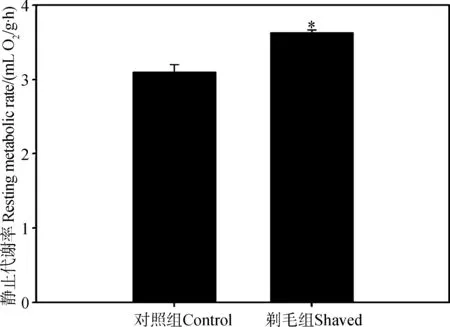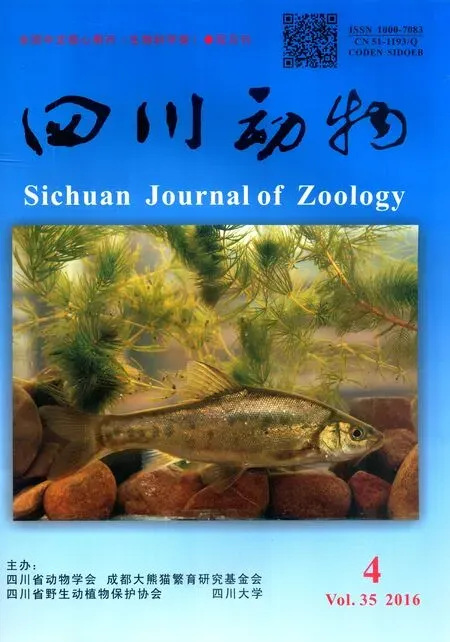剃毛对大绒鼠持续能量摄入的影响
朱万龙, 刘军, 蔡金红
(1. 云南省高校西南山地生态系统动植物生态适应进化及保护重点实验室,云南师范大学生命科学学院,昆明650500;2. 连云港师范高等专科学校,江苏连云港222006)
剃毛对大绒鼠持续能量摄入的影响
朱万龙1, 刘军2, 蔡金红1
(1. 云南省高校西南山地生态系统动植物生态适应进化及保护重点实验室,云南师范大学生命科学学院,昆明650500;2. 连云港师范高等专科学校,江苏连云港222006)
持续能量摄入(SusEI)的上限对于哺乳期母体的生存非常重要。先前的研究表明大绒鼠EothenomysmiletusSusEI的限制可能受到外周限制假说,而不支持热散失假说。为了再次验证这2个假说,本研究在哺乳早期对大绒鼠剃毛,测定剃毛组和对照组的体质量、食物摄入量、静止代谢率、胎仔数、胎仔质量和泌乳输出。结果表明:剃毛可以显著增加大绒鼠的食物摄入量和静止代谢率,但是对于胎仔数和泌乳输出没有影响。所有结果不支持热散失假说,而支持外周限制假说,说明大绒鼠在哺乳期的SusEI可能受到乳腺泌乳能力的限制。暗示在泌乳高峰期SusEI的限制在不同物种间的反应可能是不一样的。
大绒鼠;持续能量摄入;剃毛
持续能量摄入(sustained energy intake,SusEI)的上限对于哺乳动物非常重要,因为它是限制动物许多表型特性的上限,如繁殖输出、巢域行为和体温调节能力等(Petersonetal.,1990;Hammond &Diamond,1992,1997;Speakman & Krol,2005)。哺乳期是小型哺乳动物能量需求的高峰期,因此该时期是研究动物SusEI限制最好的时间(Speakman & McQueenie,1996;Johnson & Speakman,2001; Johnsonetal.,2001a;Thompson & Nicol,2002)。小型哺乳动物的SusEI受生理特征的影响(Speakman & Krol,2005)。研究表明小型哺乳动物的SusEI受能量供给系统的影响,如消化系统,即不支持中心限制假说(central limitation hypothesis)(Hammond & Diamond,1994;Hammond & Kristan,2000)。相反,很多研究证明动物的SusEI限制受到乳腺泌乳能力的影响,即支持外周限制假说(Johnsonetal.,2001b,2001c;Zhangetal.,2008)。尽管如此,也有研究结果不支持外周限制假说,如MF1小鼠在30 ℃时较21 ℃、8 ℃时食物摄入量、胎仔质量和胎仔数均显著降低,而且泌乳输出(milk energy output,MEO)也显著减少(Krol & Speakman,2003a)。MF1小鼠在剃毛后会显著增加食物摄入量和MEO(Kroletal.,2007),这些研究不支持外周限制假说,而支持热散失假说(Krol & Speakman,2003b)。
然而也有研究结果不支持热散失假说,而支持外周限制假说。如对瑞士小鼠进行部分乳腺切除,实验结果并没有出现像热散失假说预测的剩余乳腺会增加乳汁分泌的能力(Hammondetal.,1996)。剃毛对于瑞士小鼠的研究也不支持热散失假说(Zhao & Cao,2009; Zhaoetal.,2010)。对布氏田鼠Lasiopodomysbrandtii的研究表明,冷驯化条件下布氏田鼠较常温组显著增加了能量摄入和能量支出,但胎仔数也比常温组多,不支持热散失假说(Zhang & Wang,2007)。以上结果表明小型哺乳动物SusEI的限制在不同物种间可能是不一致的。
大绒鼠Eothenomysmiletus为横断山区固有种,中国特有种,主要分布于横断山及其附近地区。本研究组之前的研究表明:雌性大绒鼠在哺乳期会增加能量摄入和能量支出(Zhu & Wang,2014),大绒鼠的幼仔在胎后发育过程中,产热能力(包括肝脏和褐色脂肪组织中蛋白含量、活性)显著增加(Zhuetal.,2015)。不同胎仔数对大绒鼠SusEI的影响研究表明:增加胎仔数对SusEI的影响差异不显著,大绒鼠的SusEI/RMR约为3.6倍,即支持外周限制假说。本文在之前的研究基础上,研究剃毛对大绒鼠能量代谢、胎仔数、胎仔质量和MEO的影响,进一步验证大绒鼠的SusEI是受哪种假说的影响,为大绒鼠的生理生态学研究提供一些基础材料。
1 材料与方法
1.1 动物来源
大绒鼠为人工饲养种群,置于透明塑料鼠盒内(长260 mm×宽160 mm×高150 mm)饲养,无巢材,每盒1只;每日喂以浸泡过的玉米,用塑料瓶供水。
1.2 动物处理
挑选3~4月龄的成年雌性大绒鼠(n=32),与雄性配对14 d,14 d后移出雄性。其中16只雌性怀孕,分娩6 d后将大绒鼠按相似胎仔数分为2组:对照组8只,剃毛组8只。2组动物驯化条件为25 ℃±1 ℃,光照为12L∶12D,22 d断奶。哺乳第7天,剃毛组经乙醚麻醉后剃除全身被毛(头和尾除外),将剃除的被毛称重(精确至0.1 mg)(Zhaoetal.,2010)。
1.3 静止代谢率的测定
第22天在室内进行静止代谢率(resting metabolic rate,RMR)的测定,实验前大绒鼠在呼吸室内静置30 min左右,进入呼吸室后适应30 min,用ADML870开放式呼吸仪(AD Instruments,Pty ltd,Australia)在热中性区测定大绒鼠的RMR,温度用SPX-300型人工气候箱(上海博迅医疗设备厂)控制。呼吸室为500 mL,进入呼吸室的气体流量为200 mL·min-1,实验温度控制在(25±0.5) ℃,实验进行1.5 h,前0.5 h使大绒鼠适应呼吸室环境,之后记录1 h,每隔1 min记录1次,选取10个连续稳定的最低值来计算RMR(Zhuetal.,2008)。
1.4 体质量和食物摄入的测定
从第3天开始至第22天结束,每天测定大绒鼠的体质量、胎仔数、胎仔质量和食物摄入,定时定量饲喂(实验前一天的11∶00—13∶00,食物9.5~10.5 g),次日小心收集剩余食物(每次收集时间均在11∶00—13∶00进行)。收集的食物在烘箱中干燥至恒重(Zhuetal.,2010)。
1.5 MEO的测定
以幼仔能量收支法计算MEO(Krol & Speakman,2003b),即假设幼仔取食饲料前,其自身维持、行为活动和生长发育的能量全部来自母体泌乳,幼仔总的能量需求等于母体泌乳的能量支出。
1.6 统计分析
数据采用SPSS 13.0进行处理。体质量、食物摄入量、胎仔数和胎仔质量均采用重复测量方差分析(RM-ANOVA)。剃毛对动物的体质量、食物摄入量、胎仔数和胎仔质量的影响采用协方差分析(ANCOVA),对照组和剃毛组的体质量比较采用独立样本t检验。结果以平均值±标准误表示(Mean±SE),P<0.05为差异有统计学意义,P<0.01为差异有高度统计学意义。
2 结果
2.1 体质量
哺乳期第3天,2组体质量差异无统计学意义(t=0.23,P>0.05),剃毛前1 d2组体质量差异无统计学意义(t=0.44,P>0.05)。剃毛后,2组体质量差异无统计学意义(第7天:t=0.67,P>0.05;第22天:t=0.94,P>0.05,图1)。在整个哺乳期,对照组的体质量差异无统计学意义(F=0.85,P>0.05,图1),剃毛组的体质量差异无统计学意义(F=1.11,P>0.05,图1)。

图1 哺乳期对照组和剃毛组大绒鼠的体质量Fig. 1 Body mass of control and shaved Eothenomys miletusduring lactation
2.2 食物摄入量和RMR
哺乳期,2组的食物摄入量均显著增加(对照组:F=2.51,P<0.05;剃毛组:F=4.29,P<0.01,图2)。哺乳14 d后,2组食物摄入量差异有统计学意义(第14天:t=1.26,P<0.05;第22天:t=1.48,P<0.05)。哺乳第22天,2组RMR差异有统计学意义(t=-3.43,P<0.05,图3)。
2.3 胎仔数、胎仔质量和MEO
剃毛前,2组胎仔数差异无统计学意义(P>0.05,图4),胎仔质量差异无统计学意义(P>0.05,图5)。哺乳第22天后,2组胎仔数和胎仔质量差异无统计学意义(P>0.05)。哺乳高峰期,2组MEO差异无统计学意义(P>0.05,图6)。
3 讨论
本研究中,剃毛并没有影响大绒鼠的体质量、胎仔数和胎仔质量。但是,剃毛对哺乳高峰期大绒鼠的食物摄入量有影响:剃毛组的食物摄入量显著高于对照组。这和MF1小鼠的研究结果相似(Kroletal.,2007)。本研究结果还表明剃毛对RMR有影响:剃毛组显著高于对照组,而2组MEO之间差异无统计学意义,说明在剃毛条件下,大绒鼠食物摄入量的增加主要用于增加能量消耗(即RMR的增加),而不是增加乳汁的分泌,结果支持外周限制假说。而对照组和剃毛组大绒鼠MEO差异无统计学意义也可能说明在剃毛条件下大绒鼠的SusEI是受到乳腺泌乳能力的限制。

图2 哺乳期对照组和剃毛组大绒鼠的食物摄入量Fig. 2 Variations of food intake of control and shaved Eothenomysmiletus during lactation*P<0.05(与对照组比较); 下同。*P<0.05 (compared with control group); the same below.

图3 哺乳期对照组和剃毛组大绒鼠的静止代谢率Fig. 3 Resting metabolic rate of control and shavedEothenomys miletus during lactation

图4 哺乳期对照组和剃毛组大绒鼠的胎仔数Fig. 4 Litter size of control and shaved Eothenomys miletusduring lactation

图5 哺乳期对照组和剃毛组大绒鼠的胎仔质量Fig. 5 Litter mass of control and shaved Eothenomys miletusduring lactation

图6 哺乳期对照组和剃毛组大绒鼠的泌乳输出Fig. 6 Milk energy output of control and shaved Eothenomys miletusduring lactation
对瑞士小鼠的研究表明:虽然乳腺分泌乳汁的体积多少和胎仔质量呈正相关,但是乳汁的热值随着乳汁分泌增加而降低,在胎仔数为9~15只时,乳汁的能量差异无统计学意义(Johnsonetal.,2001c)。也有啮齿类的研究表明:乳汁的能量输出和胎仔质量没有相关性,如小白鼠Musmusculus(Konigetal.,1988)、褐家鼠Rattusnorvegicus(Fiorottoetal.,1991)和棉鼠Sigmodomhispidus(Bateman,1957)。这些结果暗示母体在哺乳体质量较大的后代时倾向减少乳汁分泌,降至体质量较小的后代每日所需的乳汁水平,但是在实验室条件下,增加体质量较小的后代并没有使母体增加乳汁的分泌(Rogowitz,1998)。在本研究中,剃毛并没有影响大绒鼠的胎仔质量和MEO,这可能说明大绒鼠SusEI受到乳腺泌乳能力的限制,支持外周限制假说。对MF1小鼠的研究表明:8 ℃条件下,小鼠的食物摄入量和产热能力均显著高于高温组(30 ℃)(Krol & Speakman,2003b),布氏田鼠在30 ℃条件下的食物摄入量显著低于低温组(Zhangetal.,2008)。此外,剃毛可以使MF1小鼠的食物摄入量增加,胎仔质量增加(Zhang & Wang,2007)。以上研究表明温度和剃毛可以增加母体的热散失,使食物摄入量和乳汁分泌正相关,从而增加繁殖输出。但是,对大绒鼠的研究发现,剃毛可以使食物摄入量增加,但并没有增加MEO,说明SusEI的限制机制在不同物种间可能是不一样的。
综上所述,剃毛组大绒鼠较对照组食物摄入量和RMR显著增加,但是剃毛对胎仔数、胎仔质量和MEO没有影响。本研究结果支持外周限制假说,即大绒鼠的SusEI可能受到乳腺泌乳能力的限制。
Bateman N. 1957. Some physiological aspects of lactation in mice[J]. Journal of Agricultural Science, 49(1): 60-77.
Fiorotto ML, Burrin DG, Perez M,etal. 1991. Intake and use of milk nutrients by rat pups suckled in small, medium or large litters[J]. American Journal of Physiology, 260(6): 1104-1113.
Hammond KA, Diamond J. 1992. An experimental test for a ceiling on sustained metabolic-rate in lactating mice[J]. Physiological Zoology, 65(5): 952-977.
Hammond KA, Diamond J. 1994. Limits to dietary nutrient intake and intestinal nutrient uptake in lactating mice[J]. Physiological Zoology, 67(1): 282-303.Hammond KA, Lloyd KCK, Diamond J. 1996. Is mammary output capacity limiting to lactational performance in mice?[J]. Journal of Experimental Biology, 199(2): 337-349.
Hammond KA, Diamond J. 1997. Maximum sustained energy budgets in humans and animals[J]. Nature, 386(6624): 457-462.
Hammond KA, Kristan DM. 2000. Responses to lactation and cold exposure by deer mice (Peromyscusmaniculatus)[J]. Physiological & Biochemical Zoology, 73(5): 547-556.
Johnson MS, Speakman JR. 2001. Limits to sustained energy intake V. Effect of cold exposure during lactation inMusmusculus[J]. Journal of Experimental Biology, 204(11): 1967-1977.
Johnson MS, Thomson SC, Speakman JR. 2001a. Limits to sustained energy intake Ⅰ. Lactation in the laboratory mouseMusmusculus[J]. Journal of Experimental Biology, 204(11): 1925-1935.
Johnson MS, Thomson SC, Speakman JR. 2001b. Limits to sustained energy intake Ⅱ. Interrelationship between resting metabolic rate, life-history traits and morphology inMusmusculus[J]. Journal of Experimental Biology, 204(11): 1937-1946.
Johnson MS, Thomson SC, Speakman JR. 2001c. Limits to sustained energy intake Ⅲ. Effects of concurrent pregnancy and lactation inMusmusculus[J]. Journal of Experimental Biology, 204(11): 1947-1956.
Konig B, Riester J, Markl H. 1988. Maternal care in house mice (Musmusculus) Ⅱ. The energy cost of lactation as a function of litter size[J]. Journal of Zoology, 216(2): 195-211.
Krol E, Speakman JR. 2003a. Limits to sustained energy intake Ⅵ. Energetics of lactation in laboratory mice at thermoneutrality[J]. Journal of Experimental Biology, 206(23): 4255-4266.
Krol E, Speakman JR. 2003b. Limits to sustained energy intake Ⅶ. Milk energy output in laboratory mice at thermoneutrality[J]. Journal of Experimental Biology, 206(23): 4267-4281.
Krol E, Murphy M, Speakman JR. 2007. Limits to sustained energy intake Ⅹ. Effects of fur removal on reproductive performance in laboratory mice[J]. Journal of Experimental Biology, 210(23): 4233-4243.
Peterson CC, Nagy KA, Diamond J. 1990. Sustained metabolic scope[J]. Proceedings of the National Academy of Sciences of the United States of America, 87(6): 2324-2328.
Rogowitz GL. 1998. Limits to milk flow and energy allocation during lactation in the hispod cotton rat (Sigmodonhispidus)[J]. Physiological Zoology, 71(3): 312-320.Speakman JR, McQueenie J. 1996. Limits to sustained metabolic rate: the link between food intake, basal metabolic rate and morphology in reproducing mice,Musmusculus[J]. Physiological Zoology, 69(4): 746-769.
Speakman JR, Krol E. 2005. Limits to sustained energy intake Ⅸ: a review of hypotheses[J]. Journal of Comparative Physiology, 175(6): 375-394.
Thompson SD, Nicol ME. 2002. Basal metabolic rate and energetics of reproduction in therian mammals[J]. Nature, 321(6071): 690-693.
Zhang XY, Wang DH. 2007. Thermogenesis, food intake and serum leptin in cold exposed lactating Brandt’s volesLasiopodomysbrandtii[J]. Journal of Experimental Biology, 210(3): 512-521.
Zhang XY, Li YL, Wang DH. 2008. Large litter size increases maternal energy intake but has no effect on UCP1 content and serum-leptin concentrations in lactating Brandt’s voles (Lasiopodomysbrandtii)[J]. Journal of Comparative Physiology, 178(178): 637-645.
Zhao ZJ, Cao J. 2009. Effect of fur removal on the thermal conductance and energy budget in lactating Swiss mice[J]. Journal of Experimental Biology, 212(16): 2541-2549.
Zhao ZJ, Chi QS, Cao J. 2010. Milk energy output during peak lactation in shaved Swiss mice[J]. Physiology & Behavior, 101(1): 59-66.
Zhu WL, Jia T, Lian X,etal. 2008. Evaporative water loss and energy metabolic in two small mammals, voles (Eothenomysmiletus) and mice (Apodemuschevrieri) in Hengduan Mountains region[J]. Journal of Thermal Biology, 33(6): 324-331.
Zhu WL, Cai JH, Lian X,etal. 2010. Adaptive character of metabolism inEothenomysmiletusin Hengduan Mountains region during cold acclimation[J]. Journal of Thermal Biology, 35(8): 417-421.
Zhu WL, Wang ZK. 2014. Resting metabolic rate and energetics of reproduction in lactatingEothenomysmiletusfrom Hengduan Mountain region[J]. Zoological Studies, 53(1): 41.
Zhu WL, Zhang H, Meng LH,etal. 2015. Variations in enzyme activity of brown adipose tissue and liver during postnatal development energy requirements during lactation inEothenomysmiletus(Mammalia: Rodentia: Cricetidae)[J]. Journal of Zoological and Bioscience Research, 2(2): 9-16.
Effect of Shaving on Sustainable Energy Intake inEothenomysmiletus
ZHU Wanlong1*, LIU Jun2, CAI Jinhong1
(1. Key Laboratory of Ecological Adaptive Evolution and Conservation on Animals-Plants in Southwest Mountain Ecosystem of Yunnan Province Higher Institutes College, School of Life Sciences, Yunnan Normal University, Kunming 650500, China;2. Lianyungang Normal College, Lianyungang, Jiangsu Province 222006, China)
The limits to sustainable energy intake (SusEI) are very important to the mammals’ survival during lactation. Previous studies suggested that the SusEI limitation ofEothenomysmiletusmay be constrained by peripheral limitation hypothesis instead of heat dissipation limitation hypothesis. To distinguish the two ideas,E.miletuswere shaved at early lactation, followed by multiple examination of body mass, food intake, resting metabolic rate (RMR), litter size and mass, and milk energy output (MEO) among the shaved mothers and non-shaved controls. The results showed that shaving could significantly increase food intake and RMR, but had no significant effects on litter mass and MEO. These data supported the peripheral limitation hypothesis rather than the heat dissipation limitation hypothesis, indicating that SusEI was more likely peripherally caused by the capacity of mammary gland to produce milk. The inconsistent responses to sustainable limits suggested that the limitations on SusEI during peak lactation might be differed in all species.
Eothenomysmiletus; sustainable energy intake; shaving
2016-03-04 接受日期:2016-05-06
国家自然科学基金项目(No. 31260097,31560126); 云南师范大学博士科研启动项目
朱万龙(1983—), 男, 副教授, 主要从事动物生理生态研究
*通信作者Corresponding author, E-mail:zwl_8307@163.com
10.11984/j.issn.1000-7083.20160046
Q95; Q959.83
A
1000-7083(2016)04-0564-05

